For the last 45 years every Labor Day weekend, the mountain village of Telluride triples in size. Waves of passionate cinephiles flood the town for a four-day experience and to embark on a movie viewing journey, spending entire days in flickering dark rooms. The Telluride Film Festival is not just a picture show– it is an experience, “Watching a film is an open processor participation in the creation of value, which evokes individual responses and shared experiences and memories” (Bosma 13). Film is not just entertainment– it is a connection. It tributes to past creators who’ve propelled the medium forward; it begins discussions with a film’s creator or the historian who is captivated by it; it is discovering that the person in line behind you made the film you just watched; it is engaging in debate with a fellow cinephile, basking in the heat of a Colorado afternoon, minutes away from a venue.
Telluride Colarado has become associated with beautiful landscape for outdoor activities and for showcasing film festivals. The scenery is astonishing to say the least and makes the several festivals held there even more desirable. Telluride Film Festival is an experience that is indescribable, allowing you to watch these carefully curated films before they hit the big theaters while enduring all the perks that follow the movie-going. Jay Carr, Boston Globe explains, “Telluride is the gem of film festivals, standing off to one side, doing its own environmentally intricate thing, devoid of the usual deal-making fever, resisting buzz in favor of discovery. It is a movie purists delight, where films, not hype, are the focus.”

Telluride Film Festival Banner on Main Street.
Goal of a Festival
Curation in any form is going to contain multiple layers of complex ideas working together to produce something that harmonizes in a near perfect symphony. Every film that someone views, their overall understanding of the film is going to be impacted when comparing how it relates to previous films they have seen before; films change the way you watch other films, whether you realize it or not. Curators excel in this industry because they understand this concept better than anyone. The collaboration between cultures creates interesting encounters between cinema, painting, photography, architecture, fashion, music, theater, or literature. Not only do other forms of medias influence each other, but also the community and the surrounding area like the landscape and history have an impact as well. Film festivals, like Telluride, offer a platform in which curators can collectively compose a programme while making the experience more intimate: symposiums, student involvement, art galleries, Q & A’s, and other scheduled events.
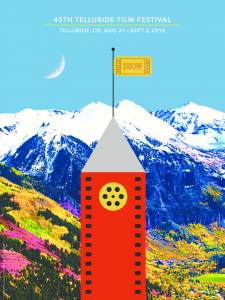
45th annual Telluride Film Festival poster.
These ‘gatekeepers’ work hard to ensure that they are not only just choosing films to present that correlate to a common theme, but also cultivating ideas through an artistic lens, managing their expenses, communicating with staff, and using their craft and entrepreneurship to give the best possible experience to whomever their intended audience members are (Bosma 8). The goal of Telluride Film Festival is to achieve this by creating these shared experiences that evokes different intimate emotions in the audience through the content presented. This is extremely crucial because the audience at Telluride has purposefully came to a screening, rather than operating like a multiplex theater where you can be dragged to a film by a friend, never creating a truly shared connection with the film and other audience members.
According to Salman Rushdie, “here are two kinds of film festival: there are the mega-hyped, hoopla-infested selling circuses, and there is Telluride. It is extraordinarily exciting, in this age of the triumph of capitalism, to discover an event dedicated not to commerce, but to love. And if that sounds old fashioned and starry-eyed, so be it. The cinema was always in the business of gazing at stars”. Telluride’s goal, even with Mountainfilm Film Festival in the spring, will never be about the glory and the fame of what they are presenting; it is a spiritual and humbling escape for those blinded by the light.
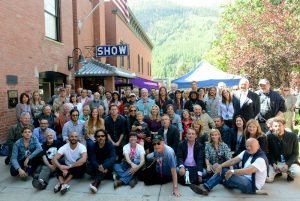
Filmmakers and other attending celebrities in Telluride (2014).
History of Telluride and Festival
In 1875, Telluride, formally referred to as Columbia, began to grow rapidly because the discovery of gold, zinc, silver, iron and copper. It wasn’t until 1880 when the small town was renamed to Telluride because of the abundance of the mineral tellurium. With such a large immigration from the British Isles and Scandinavia, the population reached 5,000 people. Once all the valuable minerals were stripped away, the townspeople dispersed, leaving the town desolate and almost forgotten. The resurrection of the town did not arise until 1972 when the winter sport of skiing allowed Telluride’s steep valleys to become one of the biggest tourist hotspots for recreational skiing.
In 1974, the beginning of the Telluride Film Festival commenced when James Card went to co-film archivist, Tom Luddy, and the owners of the Sheridan Opera House, Bill & Stella Pence, and expressed his ideas of a film collection that wasn’t accessible to anyone, one film being The Cabinet of Dr. Caligari (1921). Films that could only premiere in Telluirde was Card’s goal, parallel to film festivals everywhere; hence, showing his classic-private collection of films, “A resourceful film curator does not limit himself to the current releases, because in composing a truly interesting cinema programme he needs to have the opportunity of an unlimited choice of relevant film repertoire and film heritage to be used as counterpart or addition to the harvest of the day,” (Bosma 39).

The Sheridan as a hotel before renovations into theater.
Since 1978, they have kept records of recognizable films and influential filmmakers, celebrating the success of the cinema over the last 40 years. The Telluride Film Festival is meant to preserve and express the great accomplishments of cinema, highlighting some of its most memorable moments. Telluride exhales a naturalistic and nostalgic environment that humbles all. Steve Wasserman, from Los Angeles Times writes, “The films at Telluride, like the fresh mountain air, provide a kind of oxygen, renewing one’s faith in the idea that movies, like all great art, can still turn us inside out and make us see the world with fresh eyes”. The location of the festival the main reason it maintains the brilliant reputation it ruthlessly worked so hard to preserve. The town being engulfed and isolated in mountains, giving it the upper hand in naturalistic understanding that other major film festivals (Sundance FF and Toronto International FF) lack immensely. Like Mountainfilm, Telluride Film Festival embeds inspiration and captivating beauty into those who can access this hidden paradise of a town.
Content and Execution
When ticket and pass holders arrive in Telluride for the festival, they are unaware of what will be showing on the big screen. It isn’t until the festival officially begins that they are informed of what will be shown and in which theaters. According to the festival’s previous playbills and The National Film Preserve, the festival contains five major viewing categories: Shows, Special Medallion, Guest Director’s Selection, Backlot, and Filmmakers of Tomorrow.
“Shows” is the main attraction of the festival that consists of the flicks that are made into prestigious films. These are the movies that are going to have the big-name directors and actors that resonate with the typical audiences. A couple critically acclaimed and recent box-office hits that Telluride exhibited: Lady Bird (2017), Guillermo del Toro’s The Shape of Water (2018), Damien Chazelle’s La La Land (2017), Barry Jenkins’ Moonlight (2017), Ang Lee’s Brokeback Mountain (2005) and Jean-Marc Valleé’s Wild (2014). Celebrities also help fund the festival with their generous donations and once people get word of who will be attending, the admission ticket sales spike midway through the festival– people scrounging to get a glimpse of their idols and hoping to sit in on a Q & A.



Rooney Mara, Todd Haynes, Keith Urban, Nicole Kidman, and Emma Stone (left to right).

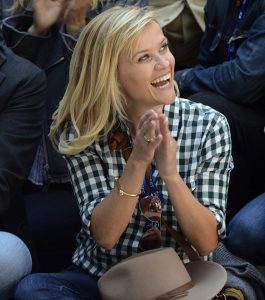
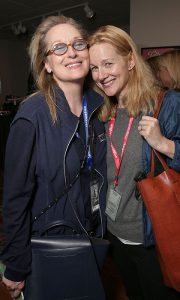
Natalie Portman, Angelina Jolie, Reese Witherspoon, Meryl Streep, and Laura Linney (left to right).
“The Special Medallion” selection is composed of films that represent a hero or an organization that honors great films and people. Usually a person who is a non-filmmaker but impacted the cinema. Past recipients include the Criterion Collection, HBO, Ted Turner, Stanley Kauffmann, Leonard Maltin and the UCLA Film and Television Archive.This is a highly sought after honor to be displayed in this section of the festival and not to be confused with the guest director section.
Each year, the festival brings in a highly-acclaimed director who collaborates with the festival staff to help with programming decisions while also composing a set of films themselves. A couple of the past directors include Laurie Anderson, Geoff Dyer, Buck Henry, Guy Maddin, Michael Ondaatje, Alexander Payne, and B. Ruby Rich. They tend to pick films that have been overlooked and over reviewed, implanting new thoughts into the minds of the audiences. They show films like Joseph Mankiewicz’s The Barefoot Contessa (1954) and Jacques Demy’ The Umbrellas of Cherbourg (1964). 2017 guest director, Joshua Oppenheimer, says, “These are six of my very favorite films. They changed me forever. They made me who I am. That they all explore power, vanity, cruelty, and the persistence of empathy, makes them urgent in these dark times. Most play like fever dreams. This is no accident. When I wake from a troubling dream and recognize my reality therein, I’m shocked into action– and that’s why I offer this selection.”

Outdoor screening of feature films from the “Show” set.
“Backlot” is one of the more intellectual sets at Telluride, for it is the only free movie viewing experience they offer. They are films that have a behind-the-scenes vibe that exploits portraits of artists, musicians and filmmakers’ life work. They present films like Hitler’s Hollywood (2017) with assertive reasoning from director Rüdiger Suchsland, whom follows the journey through the rise and fall of Nazi Germany through cinema: a tool for propaganda, a dream factory, a weapon. Another film from 2016, Beauties of the Night, directed by María José Cuevas, explores prejudices about age, sexuality and beauty, demonstrating the power of resilience and reinvention.
The most original aspect of the festival is the student involvement that Telluride encourages and hosts. For the last 25 years, they have composed a set, “Filmmakers of Tomorrow”, entirely fabricated for high school, undergrad and grad students to submit their films on an upper level platform (mostly produced short films). When creating a film series/festival schedule and deciding the screening times and dates to present your desired film, “you need to know the films and to know your audience,” (Bosma 51). Understanding that young adults at Telluride Film Festival is a clear majority of the audience, letting their involvement levels increase is crucial to the festival’s success. This allows new filmmakers to get a foothold and begin creating name for themselves. Letting the next generation transition into promising filmmakers by submitting and authorizing their work to get curated on a professional level is the best possible learning curve for the next generation.
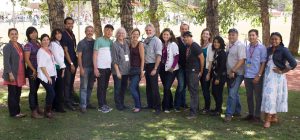
UCLA students and staff who participated in the “Filmmakers of Tomorrow” set.
Response and Financing
This is a festival dedicated to the idea of the discovery of world cinema, not the hip and the fashionable festivals. The media is constantly adapting to ‘pop culture’ and ‘contemporary content’ so having a target audience is not an entirely bad thing, but taking into consideration different ages, cultures, religions and genders is where the good film curators thrive. These films take an immense amount of effort, time and money so a free screening is costing the production of the film. As if all this wasn’t enough to balance, not only is there a need for someone to fund these projects, but also the person/company funding must be independently strong and flourishing within the market for a better outcome. Even having a prestigious investor doesn’t guarantee the success to follow, “A resourceful film curator does not limit himself to the current releases, because in composing a truly interesting cinema programme he needs to have the opportunity of an unlimited choice of relevant film repertoire and film heritage to be used as counterpart or addition to the harvest of the day,” (Bosma 39).
Telluride’s passes cost somewhere from $390 to $4,900. On average, the festival makes a total revenue of 1.8 million each year, but nearly all is put back into next years’ festival budget. Without the support of corporations, advertising and sponsorship, film festivals would seize to exist. A couple big name sponsors for Telluride is Netflix, Amazon Studios, Universal, Dell, Vimeo and many more. This festival may functionally operate as any other festival, but the experience is only one you can get in Telluride.

Telluride Main Street during the festival.
Impact and Conclusion
The Telluride Film Festival is a weekend escape for cinephiles of all social classes and ages. John Harlt from The Seattle Times wrote, “The Telluride Film Festival is widely regarded as the Tiffany of the world’s film festivals. Telluride each year draws devoted movie lovers from all over the world to this beautiful Colorado mountain town,” implying that Telluride is for those with this burning passion of cinema to express themselves freely without the media and press pressuring them. The stories and history enriched in the land surrounding Telluride only advances the moviegoeing experience while humbling those who get carried away with fame. Being a festival with no awards and no prizes enhances the filmmakers’ appreciation for others work and make it a more leisure event rather than a competition.
Telluride provides endless opportunities for those just getting started in the industry and those who have been in it for decades. This festival allows musicians, artist, poets, actors, and those with a true appreciation for the arts to captivate themselves in their environment by opening their minds up to a naturalistic festival. A.O. Scott from The New York Times describes the experience as; “it seems to exist on a higher plane, this is not just a matter of altitude. Mostly it is the kind of place where, for one long weekend, all anyone wants to talk about is movies. There are no prizes, and therefore no juries; no market, no press screenings, no red carpets or paparazzi photo calls. The ethos is open and egalitarian”. Films are going to continue to need festivals for their success, and with the Telluride Film Festival around, it is not going to be hard to do.
Works Cited
[1] Barnes, Brooks. “Lineup Set for Telluride Film Festival.” ProQuest, Sep 03, 2015.
[2] Bosma, Peter. “Film Programming; Curating for Cinemas, Festivals, Archives.” Wallflower Press-Columbia University Press, Jun 01, 2015.
[3] Rottenberg, Josh. “From ‘First Man’ to ‘Roma,’ Oscar Season Comes into Focus at Telluride Film Festival.” ProQuest, Sep 04, 2018.
[4] Rottenberg, Josh. “Telluride Film Festival Set to Kick Off Oscar Season in its Own Uniquely Casual Way.” ProQuest, Aug 30, 2018.
[5] Rushdie, Salman. “No Prizes for the Best Celebration of Cinema.” The Guardian, Sep 07, 2001. Accessed 7 Dec. 2018.
[6] Scott, A. O. “At the Telluride Film Festival, the Past Isn’t Safe at all.” ProQuest, Sep 03, 2018.
[7] “Telluride.” Britannica Academic, Encyclopedia Britannica, Aug 27, 2012. Accessed 19 Nov. 2018.
[8] “Telluride Film Festival.” Britannica Academic, Encyclopedia Britannica, Aug 12, 2010. Accessed 19 Nov. 2018.
[9] Pristin, Terry.“FILM; The Festival That Tries To Dodge the Spotlight,” The New York Times, Aug 30, 1998.
[10] “James Card; Telluride Film Festival Co-Founder,” Los Angeles Times, Jan 21, 2000.
[11] “45thTelluride Film Festival” The National Film Preserve, Accessed 7 Dec. 2018. www.telluridefilmfestival.org

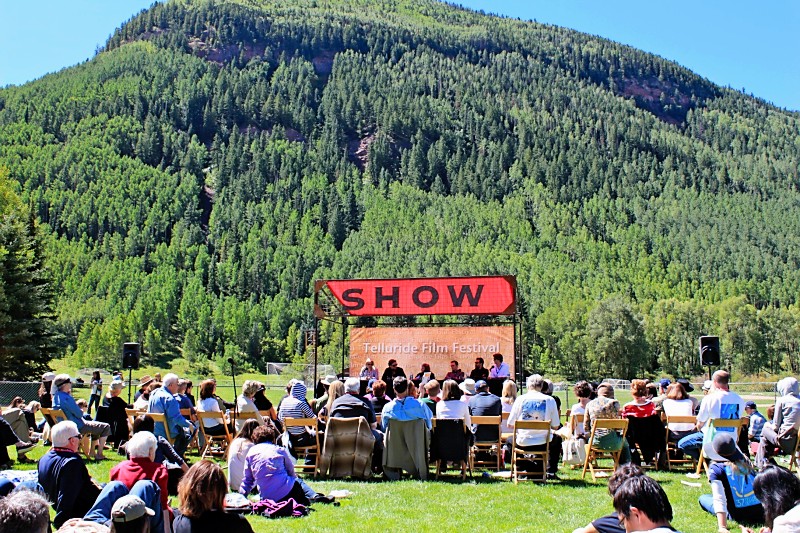
Recent Comments